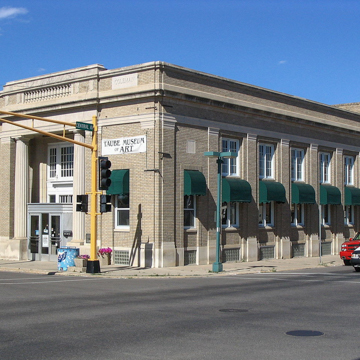You are here
Lillian and Coleman Taube Museum of Art (Union National Bank and Annex)
In 1923 a devastating fire destroyed the Union National Bank of 1909 on this site. Although the economy was uncertain, the bank chose to rebuild and hired Bugenhagen, a prominent Minot architect. He chose the symbolism of Classical Revival to portray the bank’s image as a stable institution. With two colossal Doric columns supporting a full entablature at the entrance, the bank presents an imposing formal facade at Minot’s major commercial intersection. The bank’s annex to the east was built for offices and retail stores. Bugenhagen, who had a background in engineering and construction and many established clients, seems to have had a running conflict with the newly established state licensing board for architects as he tried to establish his credentials and qualifications to their satisfaction. In the 1920s he attained that objective, and in the 1930s, he formed a partnership with two other Minot architects and engineers, Deeter and Hess. Together they developed the Art Deco design for the Emmons County Courthouse (EM1) in Linton. The bank moved to a different location in 1963, and in 1997 the museum acquired the building.
Writing Credits
If SAH Archipedia has been useful to you, please consider supporting it.
SAH Archipedia tells the story of the United States through its buildings, landscapes, and cities. This freely available resource empowers the public with authoritative knowledge that deepens their understanding and appreciation of the built environment. But the Society of Architectural Historians, which created SAH Archipedia with University of Virginia Press, needs your support to maintain the high-caliber research, writing, photography, cartography, editing, design, and programming that make SAH Archipedia a trusted online resource available to all who value the history of place, heritage tourism, and learning.






